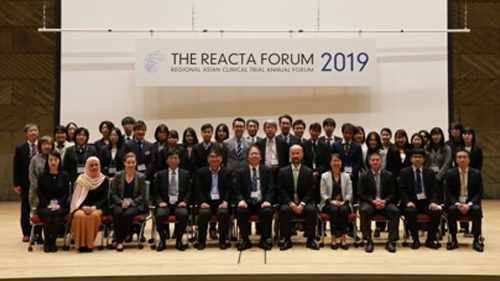Investigator-Initiated Registry Trials in Japan and the REACTA Network in Asia
Chiba University Hospital
cademic research organizations (AROs) are ideally positioned to conduct collaborative clinical trials worldwide. Particularly regarding orphan diseases, rare cancer, and pediatric diseases that are difficult for pharmaceutical companies to address, it may be possible for academia to take the initiative in conducting clinical trials and solving various issues.
Japan ARO and DCRI Models
The term ARO has only recently been recognized in Japan. Twelve institutions have now been certified as clinical research core hospitals that fulfill the ARO requirements listed in the Japanese Medical Law since 2012. AROs in Japan serve three functions: Translational Research Center, Phase 1 Unit, and Coordinating Center.
In addition, the Investigator-Initiated Registry Trial (IRT) is a unique system in Japan. IRTs are registration trials initiated by investigators in the fields of medicine, medical devices, and regenerative medicine. They are intended not only to test new compounds, but also to expand the indications of approved drugs. This latter task is required in Japan because the national insurance system is linked to the PMDA approval system, and without PMDA approval, insurance cannot be used at hospitals.
CCRC-ARO at Chiba University was established in 2007, and its staff has grown from seven members to about 100. Our approach is to actively plan and execute clinical trials on our own, and we model ourselves after DCRI’s ARO. Our mission is to create new treatments for patients through scientific and ethical clinical trials.
A big difference between CCRC-ARO and DCRI is that our organization is new and small; this is an advantage. In order to become a compact, agile institution, we hire individuals with corporate experience for our leadership roles, and we continuously recruit young people and nurture all staff members across the organization. The implementation of clinical trial projects requires a cross-organizational team structure, and a system is established for senior professionals to mentor younger ones.
We received approval from PMDA on February 21, 2020 to expand the indications for cyclosporine as a new treatment for Kawasaki disease. Kawasaki disease is an acute vasculitis of unknown cause that predominantly affects infants and young children, causes coronary artery abnormalities such as aneurysms and dilations in about 25 percent of untreated patients, and is the leading cause of acquired heart disease in children in high-income countries.
The KAICA trial (a Kawasaki disease study to assess the efficacy of Immunoglobulin plus Cyclosporin A (CsA)) was a comparative randomized study that enrolled 200 infants. The results of the study were published in Lancet in 2019, and we obtained approval from PMDA for the additional indication for CsA as severe Kawasaki disease. In addition to our ARO activities, collaboration between investigators, regulators, companies, and funding agencies is essential for conducting IRT trials.
Pharmacological effects relevant to Kawasaki disease had been studied in basic research before clinical trials were conducted. However, it was important to analyze gene expression in patients with severe Kawasaki disease and to clarify the mechanism whereby gene overexpression was suppressed. The efficacy in patients with this gene expression in clinical trials was 100 percent when treated with cyclosporine. This illustrates how essential it is for academia to connect basic and clinical research or to “translate” research findings in this way.
Regulatory science is an important factor in performing clinical trials. In PMDA consultations, PMDA and academia conduct scientific discussions and determine the appropriate study design. Furthermore, Chiba University has set up a graduate school in cooperation with PMDA, and it also conducts research in the field of regulatory science and provides doctoral student education.
It is well known that the development of PD-1 drugs was not prioritized by Japanese pharmaceutical companies and the government; instead, it was led by US pharmaceutical company Bristol Myers Squibb after the discovery of PD-1 by Professor Tasuku Honjo’s research team at Kyoto University. Later, Honjo received the Nobel Prize for his work on PD-1. This then led to the establishment of a funding agency of medical research and development (AMED) and AROs that have translational research function to support researchers.
Network and Collaboration
Of course, stakeholders in clinical trials include not only academia but also companies and regulators. Therefore, it is necessary to have a network for discussing clinical trial methods and global trends with stakeholders. Region Asia Clinical Trial Association (REACTA) is an international network of research institutes that includes four countries: Japan, South Korea, Taiwan, and Malaysia. It was established in 2013 and holds a scientific forum every year. Chiba hosted the REACTA forum in 2015 and 2019, inviting speakers from academia, regulators, and pharmaceutical companies.


